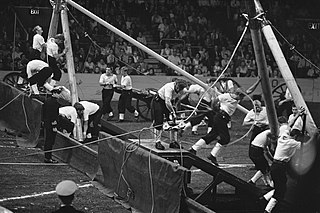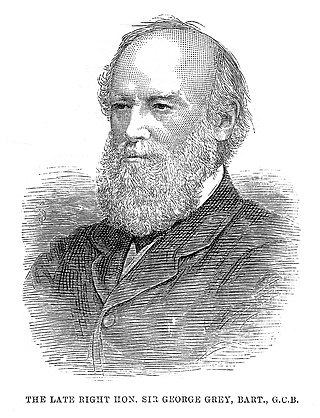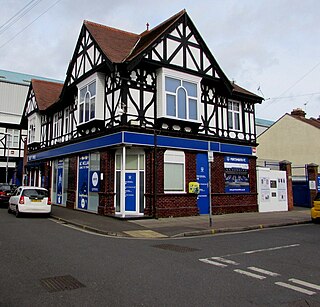
Stout is a dark beer that is generally warm fermented, such as dry stout, oatmeal stout, milk stout and imperial stout, though can also be cold fermented, such as Baltic porter.

Samuel Whitbread was an English brewer and Member of Parliament. In 1742, he established a brewery that in 1799 became Whitbread & Co Ltd.

Admiral Francis Holburne was a Royal Navy officer and politician. He served as commodore and commander-in-chief at the Leeward Islands during the War of the Austrian Succession and then took part in an operation to capture Louisbourg as part of the Louisbourg Expedition during the Seven Years' War. He went on to be Port Admiral at Portsmouth and then Senior Naval Lord. In retirement he became Governor of Greenwich Hospital. He also served as a Member of Parliament.
Whitbread is a British multinational hotel and restaurant company headquartered in Houghton Regis, England.

The Royal Navy's command field gun competition was a contest between teams from three Royal Navy commands, in which teams of sailors compete to transport a field gun and its equipment over and through a series of obstacles in the shortest time. The competition evolved during the early years of the 20th century. The "Command" format, negotiating walls and a chasm, was held annually at the Royal Tournament in London solely as a public display and as recruitment purposes from 1907 until 1999, apart from the periods during the World Wars. The "Inter-Port" or "Command" Competition was contested by teams from the Royal Navy annually, and was a popular item at the Royal Tournament until finishing in 1999.
Sir David Martyn Evans-Bevan was a wealthy industrialist from south Wales. He was the owner of the Vale of Neath Brewery, and purchased Margam Castle from the Talbot family.
There have been two baronetcies created for persons with the surname Mann, one in the Baronetage of Great Britain and one in the Baronetage of the United Kingdom.
Colonel Sir William Thomas Dupree, 1st Baronet, was an English brewer.

The Ordnance QF 12-pounder 8 cwt was a Royal Navy "landing gun" intended for navy use ashore. "8 cwt" refers to the weight of the gun and breech, approximately 8 cwt = 8 x 112 lb (51 kg) = 896 lb (406 kg). This was how the British often differentiated between guns of the same calibre or weight of shell. This gun had a short barrel and was of relatively low power compared to the 12 pounders of 12 and 18 long cwt, although it fired the same shells.
There have been two baronetcies created for persons with the surname Hughes, one in the Baronetage of Great Britain and one in the Baronetage of the United Kingdom. One creation is extant as of 2008.
Sir Edmund Hope Verney, 3rd Baronet FRGS, DL, JP was a British naval officer, author and Liberal politician who sat in the House of Commons in two periods between 1885 and 1891.
Lothian George Bonham-Carter was an English first-class cricketer and businessman involved in brewing.
John Brickwood may refer to:

Sir George Grey, 1st Baronet, was a British Royal Navy officer and a scion of the noble House of Grey who served as Master and Commander of the Mediterranean Fleet. He joined the Royal Navy at the age of 14 and was on active service from 1781 to 1804, serving in the American War of Independence, the French Revolutionary War and the Napoleonic War. He served as Flag Captain for John Jervis, Earl of St Vincent and later as Flag Captain for King George III on his royal yacht. From 1804 to 1806, he was Commissioner at Sheerness Dockyard, and from 1806 until his death in 1828 he was Commissioner at Portsmouth Dockyard.

Sir Charles Saxton, 1st Baronet was an officer of the Royal Navy who saw service during the War of the Austrian Succession, the Seven Years' War, the American War of Independence and the French Revolutionary and Napoleonic Wars, rising to the rank of captain.

Vice-Admiral Sir Charles George Frederick Knowles, 4th Baronet was an officer of the Royal Navy, who saw service during the Second Burmese War and in command on the Niger expedition and quelling uprising at Santa Cruz, eventually rising to the rank of vice-admiral.
Sir Charles Henderson Tidbury, DL was an English brewing executive who was Chairman of Whitbread and President of the Institute of Brewing.

Arthur Edward Cogswell was an English architect, particularly active in the Portsmouth area. He was an architect who, although not well known nationally, left a strong mark on the appearance of Portsmouth lasting until this day.

Frederick Thomas Michell KCB (1788–1873) was a British commander in the Royal Navy. He was also Mayor of Totnes from 1855 to 1858.
Captain Sir Richard Hughes, 1st Baronet was a Royal Navy officer of the eighteenth century who served as Resident Commissioner of Portsmouth Dockyard. Hughes joined the navy in 1721 and served on a variety of ships, some commanded by his father Captain Richard Hughes, mostly in the Mediterranean Sea and Baltic Sea, and was also a some-time follower of Admiral Sir John Norris. He was promoted to commander in 1739 and given command of HMS Anne Galley, and was promoted to post-captain in the following year. Having served mostly in command of ships in the Mediterranean Fleet, Hughes was given command of the guardship HMS Fougueux in 1753, from where he was appointed Resident Commissioner of Portsmouth in 1754. He served there until 1773, in which year he was created a baronet and then retired. He died at Southampton, aged 71.











